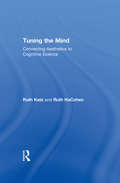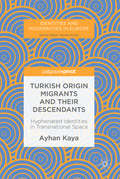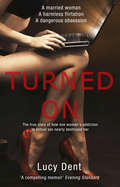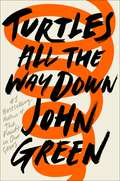- Table View
- List View
Truth, Reality and the Psychoanalyst: Latin American Contributions to Psychoanalysis (Ipa: The International Psychoanalysis Library)
by Silvia FlechnerPsychoanalysis has long thrived in Latin America. Like the rest of the psychoanalytic world, our Latin American colleagues are diverse in their thinking, but there is nevertheless a distinct cultural voice with which they speak. Unfortunately, language barriers have interfered with the communication of this unique and highly sophisticated way of thinking to colleagues around the world. This stimulating new volume goes a long way to fill this void by presenting a collection of essays that present Latin American psychoanalysis at its best. An added treat is the cross-cultural dialogue provided by commentators for each chapter from other psychoanalytic cultures. I highly recommend this exciting new contribution to both candidates and experienced analysts.
Truth, Trust And Relationships: Healing Interventions In Contextual Therapy
by Barbara R. Krasner Austin J. JoyceThe authors identify direct address, a dialogic way of address and response, as the fundamental means of healing in relationships, especially in the family, viewing "residual trust" as the keystone of the dialogic process.
Truth, Trust And Relationships: Healing Interventions In Contextual Therapy
by Barbara R. Krasner Austin J. JoyceThe authors identify direct address, a dialogic way of address and response, as the fundamental means of healing in relationships, especially in the family, viewing "residual trust" as the keystone of the dialogic process.
Tryptophan, Serotonin, and Melatonin: Basic Aspects and Applications (Advances in Experimental Medicine and Biology #467)
by Gerald Huether Walter Kochen Thomas J. Simat Hans SteinhartThis volume contains the proceedings of the Ninth Meeting of the "International Study Group for Tryptophan Research" (lSTRY), held at the University of Hamburg, Germany, from October 10 to 14, 1998. At this meeting the recent developments in the field of tryptophan research were presented by leading researchers from all over the world in 81 oral and 48 poster contri butions. Research on tryptophan and its derivatives provides an inexhaustible subject. At the conference we tried to compose a multifacetted picture of the recent investiga tions through contributions from the major disciplines involved. Thus, we tried to strike a balance between basic research topics and clinical, nutritional or industrial applica tions. We offered workshops on tryptophan (in sleep and mood), melatonjn, IDO-acti vation and the eosinophilia-myalgia syndrome (EMS) as a platform for intensive discussion for the participants. In these proceedings many contributions are multidisciplinary and have practical or theoretical implications for different research fields. Hence, we have organized this volume in nine main chapters according to basic disciplines and subjects. We are aware that this classification is artificial, but we hope that it is the best compromise for contributors and readers.
TA Today (PDF): A New Introduction To Transactional Analysis
by Ian Stewart Vann JoinesThis title, now in its second edition, is an introduction to the psychological system known as transactional analysis (TA). It is aimed at the general reader as well as at TA trainees and practitioners.
Tuberous Sclerosis Complex (Developmental Perspectives in Psychiatry)
by Manuel Rodriguez Gomez Julian R. Sampson Vicky Holets WhittemoreTuberous Sclerosis is a genetic disease characterized by lesions of the skin and central nervous system, seizures, and sometimes sever mental retardation. Infants with this disease may appear overactive, autistic, or socially impaired. Because tuberous sclerosis involves abnormal cellular differentiation, aberrant neuronal migration, and excessive cell proliferation, this thoroughly revised edition will be of interest to a wide range of professionals involved in the study of biological mechanisms underlying many genetically determined neurological disorders.
Tuning the Mind: Connecting Aesthetics to Cognitive Science
by Ruth HaCohenStarting from the late Renaissance, efforts to make vocal music more expressive heightened the power of words, which, in turn, gave birth to the modern semantics of musical expression. As the skepticism of seventeenth-century science divorced the acoustic properties from the metaphysical qualities of music, the door was opened to dicern the rich links between musical perception and varied mental faculties. In Tuning the Mind, Ruth Katz and Ruth HaCohen trace how eighteenth century theoreticians of music examined anew the role of the arts within a general theory of knowledge.As the authors note, the differences between the physical and emotional dimensions of music stimulated novel conceptions and empirical inquiries into the old aesthetic queries. Tracing this development, their opening chapter deals with seventeenth-century epistemological issues concerning the artistic qualities of music. Katz and HaCohen show that painting and literature displayed a comparable tendency toward "musicalization," whereby the dynamic of forms-the modalities specific to each artistic medium-rather than subject matter was believed to determine expression. Katz and HaCohen explore the ambiguities inherent in idealization of an art form whose mimetic function has always been problematic. They discuss the major outlines of this development, from Descartes to Vico through Condillac. Particular emphasis is placed on eighteenth-century British thinkers, from Shaftesbury to Adam Smith, who perceived these problems in their full complexity. They also explore how the French and the Germans dealt differently with questions that preoccupied the British, each nation in accordance with their own past tradition and tendencies. The concluding chapter summarizes the parallel development of abstract art and basic hypotheses concerning the mind and explores basic theoretical questions pertaining to the relationship between perception and cognition.In addressing some of the most complex problems in musical aesthetics, Katz and HaCohen provide a unique historical perspective on the ways their art creates and develops coherent worlds, and, in so doing, contribute to our understanding of the workings of the mind.
Tuning the Mind: Connecting Aesthetics to Cognitive Science
by Ruth HaCohenStarting from the late Renaissance, efforts to make vocal music more expressive heightened the power of words, which, in turn, gave birth to the modern semantics of musical expression. As the skepticism of seventeenth-century science divorced the acoustic properties from the metaphysical qualities of music, the door was opened to dicern the rich links between musical perception and varied mental faculties. In Tuning the Mind, Ruth Katz and Ruth HaCohen trace how eighteenth century theoreticians of music examined anew the role of the arts within a general theory of knowledge.As the authors note, the differences between the physical and emotional dimensions of music stimulated novel conceptions and empirical inquiries into the old aesthetic queries. Tracing this development, their opening chapter deals with seventeenth-century epistemological issues concerning the artistic qualities of music. Katz and HaCohen show that painting and literature displayed a comparable tendency toward "musicalization," whereby the dynamic of forms-the modalities specific to each artistic medium-rather than subject matter was believed to determine expression. Katz and HaCohen explore the ambiguities inherent in idealization of an art form whose mimetic function has always been problematic. They discuss the major outlines of this development, from Descartes to Vico through Condillac. Particular emphasis is placed on eighteenth-century British thinkers, from Shaftesbury to Adam Smith, who perceived these problems in their full complexity. They also explore how the French and the Germans dealt differently with questions that preoccupied the British, each nation in accordance with their own past tradition and tendencies. The concluding chapter summarizes the parallel development of abstract art and basic hypotheses concerning the mind and explores basic theoretical questions pertaining to the relationship between perception and cognition.In addressing some of the most complex problems in musical aesthetics, Katz and HaCohen provide a unique historical perspective on the ways their art creates and develops coherent worlds, and, in so doing, contribute to our understanding of the workings of the mind.
tuPOY: Silicon of the Future (Advanced Structured Materials #23)
by H.D. Mustafa Sunil H. Karamchandani Shabbir N. Merchant Uday B. DesaiThis book provides a new direction in electronics research with the invention of a new material tuPOY, which changes our perception of developing electronics. Evolving on a relatively underplayed phenomenon of static electricity in scientific exploration and application, tuPOY upholds the potential to rival both silicon and metals as electronics of the future. Devices made of tuPOY present a new emblem to the technological world, where we could envision our electronic paraphernalia from a completely different perspective. A computer the size of a big wall, which could be neatly folded and kept in our pockets when not in use and laundered on a regular basis, can be imagined possible with this invention. The concept, manufacturing process, physics and uses of tuPOY as the next generation material of electronics is described in this book. The book covers the production process of tuPOY and goes on to conceptual advancement from manipulating the sensing, radiating and processing properties of tuPOY. Theoretical modelling of tuPOY is characterized by steady-state equations exploiting interchanges based on the lattice kinetics, which mathematizes an Interchange Phenomenon in tuPOY. The numerical manifestations calibrate mathematically, tuPOY’s response to any external physical impetus such as charge, heat or energy flow. The book validates the sensing properties and theoretical model by designing a tuPOY sensor which can be used in a plethora of applications. A novel microstrip antenna is designed by amalgamation of tuPOY, raw silk and polynylon composites to experimentally verify the radiation properties of the new material. The conduction properties are verified by drawing fibres of tuPOY and using them as wires and connectors in electronics. A Power Generating Unit (PGU) is designed with tuPOY as its primary element. This is a first of its kind PGU that scavenges power from thermal energy presenting a new dimension in operational power dynamics. Overall this book should be of interest to a wide range of readers ranging from researchers, scientists, developers, manufacturers, engineers, graduate students and anyone who has satiety to think differently.
Turkish Origin Migrants and Their Descendants: Hyphenated Identities in Transnational Space (Identities and Modernities in Europe)
by Ayhan KayaThis book analyses Muslim-origin immigrant communities in Europe, and the problematic nature of their labelling by both their home and host countries. The author challenges the ways in which both sending and receiving countries encapsulate these migrants within the religiously defined closed box of “Muslim” and/or “Islam”. Transcending binary oppositions of East and West, European and Muslim, local and newcomer, Kaya presents the multiple identities of Muslim-origin immigrants by interrogating the third space paradigm.Turkish Origin Migrants and Their Descendants analyses the complexity of the hyphenated identities of the Turkish-origin community with their intricate religious, ethnic, cultural, ideological and personal elements. This insight into the life-worlds of transnational individuals and local communities will be of interest to students and scholars of the social sciences, migration studies, and political science, especially those concerned with Islamization of radicalism, populism, and Islamophobia in a European context.
Turkish Origin Migrants and Their Descendants: Hyphenated Identities in Transnational Space (Identities and Modernities in Europe)
by Ayhan KayaThis book analyses Muslim-origin immigrant communities in Europe, and the problematic nature of their labelling by both their home and host countries. The author challenges the ways in which both sending and receiving countries encapsulate these migrants within the religiously defined closed box of “Muslim” and/or “Islam”. Transcending binary oppositions of East and West, European and Muslim, local and newcomer, Kaya presents the multiple identities of Muslim-origin immigrants by interrogating the third space paradigm.Turkish Origin Migrants and Their Descendants analyses the complexity of the hyphenated identities of the Turkish-origin community with their intricate religious, ethnic, cultural, ideological and personal elements. This insight into the life-worlds of transnational individuals and local communities will be of interest to students and scholars of the social sciences, migration studies, and political science, especially those concerned with Islamization of radicalism, populism, and Islamophobia in a European context.
Turn the Tide on Climate Anxiety: Sustainable Action for Your Mental Health and the Planet
by Megan Kennedy-Woodard Dr. Patrick Kennedy-WilliamsIt's hard to watch the news, scroll through social media, or listen to the radio without hearing or seeing something disturbing about the climate emergency. This can trigger all sorts of emotions: worry, anger, sadness, guilt, and even grief but also often over-looked positive emotions like motivation, connection, care, and abundance that support mental health and climate action for sustainable longevity.Written by psychologists with extensive experience in treating people with eco-anxiety, this book shows you how to harness these emotions, validate them, and transform them into positive action. It enables you to assess and understand your psychological responses to the climate crisis and move away from unhealthy defence mechanisms, such as denial and avoidance.Ultimately, it shows that the solution to both climate anxiety and the climate crisis is the same - action that is sustainable for you and for the planet - and empowers you to take steps towards this.
Turned On: The True Story Of How One Woman's Addiction To Virtual Sex Nearly Destroyed Her
by Lucy DentAt the curtain call of her thirties, Lucy Dent finds herself in a marriage where meaningful communication, sexual contact and friendship have all but disappeared. Craving comfort and attention, she turns to the internet to find companionship and finds fulfilment in online sexual liaisons.Lucy details her sexual encounters with searing honesty - but this book is so much more than a 'sex memoir'. It explores marital disharmony, loneliness, addiction and the ramifications of making the choice not to have children. In an age in which lives are played out via social networks, this compelling book exposes how the supposed security of online interaction doesn't, in fact, stay safe for very long.
Turned On: Science, Sex and Robots
by Kate DevlinThe idea of the seductive sex robot is the stuff of myth, legend and science fiction. From the myth of Laodamia in Ancient Greece to twenty-first century shows such as Westworld, robots in human form have captured our imagination, our hopes and our fears. But beyond the fantasies there are real and fundamental questions about our relationship with technology as it moves into the realm of robotics.Turned On explores how the emerging and future development of sexual companion robots might affect us and the society in which we live. It explores the social changes arising from emerging technologies, and our relationships with the machines that someday may care for us and about us. Sex robots are here, and here to stay, and more are coming. Computer scientist and sex-robot expert Kate Devlin is our guide as we seek to understand how this technology is developing. From robots in Greek myth and the fantastical automata of the Middle Ages through to the sentient machines of the future that embody the prominent AI debate, she explores the 'modern' robot versus the robot servants we were promised by twentieth century sci-fi, and delves into the psychological effects of the technology, and issues raised around gender politics, diversity, surveillance and violence. This book answers all the questions you've ever had about sex robots, as well as all the ones you haven't yet thought of.
Turning Points in Dynamic Psychotherapy: Initial Assessment, Boundaries, Money, Disruptions and Suicidal Crises
by Salman AkhtarThis book addresses five areas of difficulty in psychotherapy: initial assessment, boundaries, money, disruptions, and suicidal crises. It outlines the conceptual issues and the technical details of each of the concept in detail.
Turning Points in Dynamic Psychotherapy: Initial Assessment, Boundaries, Money, Disruptions and Suicidal Crises
by Salman AkhtarThis book addresses five areas of difficulty in psychotherapy: initial assessment, boundaries, money, disruptions, and suicidal crises. It outlines the conceptual issues and the technical details of each of the concept in detail.
Turning Points in Play Therapy and the Emergence of Self: Applications of the Play Therapy Dimensions Model
by Lorri Yasenik and Ken GardnerGiving examples of how the proven Play Therapy Dimensions model can be applied in a range of clinical settings, this edited book demonstrates the benefits of it. Comprised of case studies and worked examples, fully supported by different theoretical models, this book will be of interest to play therapists and students alike.
Turning the Tide: The Psychoanalytic Approach of the Fitzjohn's Unit to Patients with Complex Needs
by Rael Meyerowitz David BellSince it was founded in 1920, the Tavistock Clinic has developed a wide range of developmental approaches to mental health which have been strongly influenced by the ideas of psychoanalysis. It has also adopted systemic family therapy as a theoretical model and a clinical approach to family problems. The Clinic is now the largest training institution in Britain for mental health, providing postgraduate and qualifying courses in social work, psychology, psychiatry, and child, adolescent, and adult psychotherapy, as well as in nursing and primary care. It trains about 1,700 students each year in over 60 courses. This important volume traces an impressive range of descriptions, all clinically based, of the work of the remarkable Fitzjohn's Unit, which has about 60 patients under its care at any one time. The book also evokes a clear sense of collective commitment, one that has lasted over seventeen years, since its beginnings as an experimental project that was set up by David Taylor in 2000.
Turning the Tide: The Psychoanalytic Approach of the Fitzjohn's Unit to Patients with Complex Needs
by Edna O'ShaughnessySince it was founded in 1920, the Tavistock Clinic has developed a wide range of developmental approaches to mental health which have been strongly influenced by the ideas of psychoanalysis. It has also adopted systemic family therapy as a theoretical model and a clinical approach to family problems. The Clinic is now the largest training institution in Britain for mental health, providing postgraduate and qualifying courses in social work, psychology, psychiatry, and child, adolescent, and adult psychotherapy, as well as in nursing and primary care. It trains about 1,700 students each year in over 60 courses. This important volume traces an impressive range of descriptions, all clinically based, of the work of the remarkable Fitzjohn's Unit, which has about 60 patients under its care at any one time. The book also evokes a clear sense of collective commitment, one that has lasted over seventeen years, since its beginnings as an experimental project that was set up by David Taylor in 2000.
Turtles All the Way Down
by John GreenJohn Green, the #1 bestselling author of The Fault in Our Stars is back, with a book hailed by the Guardian as 'a new modern classic'.'It's quite rare to find someone who sees the same world you see.'Sixteen-year-old Aza never intended to pursue the mystery of fugitive billionaire Russell Pickett, but there's a hundred thousand dollar reward at stake and her Best and Most Fearless Friend, Daisy, is eager to investigate. So together, they navigate the short distance and broad divides that separate them from Russell Pickett's son, Davis.Aza is trying. She is trying to be a good daughter, a good friend, a good student, and maybe even a good detective, while also living within the ever-tightening spiral of her own thoughts. In his long-awaited return, John Green, the acclaimed, award-winning author of Looking for Alaska and The Fault in Our Stars, shares Aza's story with shattering, unflinching clarity in this brilliant novel of love, resilience, and the power of lifelong friendship.First edition includes an exclusive jacket poster featuring some of John's most brilliant and memorable quotes.
Tutorial Essays in Psychology: Volume 2
by N. S. SutherlandFirst published in 1979. Routledge is an imprint of Taylor & Francis, an informa company.
Tutorial Essays in Psychology: Volume 1
by N. S. SutherlandFirst published in 1977. Routledge is an imprint of Taylor & Francis, an informa company.
Tutorial Essays in Psychology: Volume 2
by N. S. SutherlandFirst published in 1979. Routledge is an imprint of Taylor & Francis, an informa company.
Tutorial Essays in Psychology: Volume 1
by N. S. SutherlandFirst published in 1977. Routledge is an imprint of Taylor & Francis, an informa company.
Tutorials in Bilingualism: Psycholinguistic Perspectives
by Annette M. B. de Groot Judith F. KrollThe past fifteen years have witnessed an increasing interest in the cognitive study of the bilingual. A major reason why psychologists, psycholinguists, applied linguists, neuropsychologists, and educators have pursued this topic at an accelerating pace presumably is the acknowledgment by increasingly large numbers of language researchers that the incidence of monolingualism in individual language users may be lower than that of bilingualism. This alleged numerical imbalance between monolinguals and bilinguals may be expected to become larger due to increasing international travel through, for instance, tourism and trade, to the growing use of international communication networks, and to the fact that in some parts of the world (i.e., Europe), the borders between countries are effectively disappearing. In addition to the growing awareness that bilinguals are very common and may even outnumber monolinguals, there is the dawning understanding that the bilingual mind is not simply the sum of the cognitive processes associated with each of the two monolingual modes, and that the two languages of bilingual may interact with one another in complicated ways. To gain a genuinely universal account of human cognition will therefore require a detailed understanding of language use by both pure monolinguals as well as bilinguals, unbalanced and balanced, and of the representations and processes involved. These two insights, that bilingualism is a common human condition and that it may influence cognition, were presumably instrumental in putting bilingualism on the agendas of many researchers of cognition and language in recent years. But other reasons may have played a role too: The study of bilingualism also provides a unique opportunity to study the relation between language and thought. A final reason for the growing interest in this area of research is the awareness that bilingualism may confer the benefit of broadening one's scope beyond the limits of one's own country and culture. This book serves as an excellent introduction to the important topics in the psycholinguistic study of bilingualism. The chapters represent a comprehensive and interrelated set of topics that form the core of contemporary research on the psycholinguistics of bilingualism. The issues raised within this perspective not only increase our understanding of the nature of language and thought in bilinguals but also of the basic nature of the mental architecture that supports the ability to use more than one language.

















